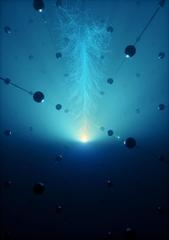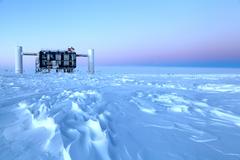URL: https://www.desy.de/news/news_search/index_eng.html
Breadcrumb Navigation
DESY News: A bigger IceCube will open a window to the extreme universe
News
News from the DESY research centre
A bigger IceCube will open a window to the extreme universe
The neutrino telescope IceCube in Antarctica has established the new discipline of neutrino astronomy with landmark observations. To fully exploit the potential of the observatory, the international collaboration behind IceCube plans a major extension of the detector that is frozen underground into the eternal ice of the South Pole. A white paper submitted to the Journal of Physics G outlines the need for and design of IceCube-Gen2, the next-generation extension of IceCube. By adding new optical and radio instruments to the existing detector, IceCube-Gen2 will increase the annual rate of cosmic neutrino observations by an order of magnitude, and its sensitivity to point sources will increase to five-times that of IceCube.

IceCube looks for the light from the particle showers that trigger neutrino collisions with the underground ice. Credit: DESY, Science Communication Lab
Projected to be completed in 2033 with construction costs around 300 million euros, IceCube-Gen2 is a major endeavor. The first step is already underway with the IceCube Upgrade, funded by the U.S. National Science Foundation NSF and also by the Helmholtz Association, which will add seven strings with new and enhanced optical modules to DeepCore, the center of the IceCube array. The next phase will be to add 120 additional strings, which will be spaced about 240 meters apart in a sunflower-like pattern around IceCube that is designed to encompass a large volume while avoiding “corridors” through which misleading signals may pass. The new digital optical modules, or DOMs, which should be able to collect nearly three times as many photons as current IceCube DOMs, will be spaced 16 meters apart on the string, between 1.3 and 2.6 kilometers below the surface, resulting in a total detector volume of nearly eight cubic kilometers.

Scheme of the planned extension to IceCube Generation 2. Credit: IceCube
Near the surface, IceCube-Gen2 will have a new radio component made up of detector “stations” covering an area of approximately 500 square kilometers. Each station consists of three strings holding radio antennas that will be deployed close to the surface of the ice. This array will detect radio emission generated in the ice by particle showers, allowing scientists to reconstruct the energy of the shower and arrival direction of the neutrino. “With the collaboration embracing the radio technique as a complementary tool to target the very highest energies, I look forward to finding many ‘firsts’ in this uncharted territory,” says radio detector specialist Anna Nelles from DESY.

“Neutrinos are but a recent addition to the palette of tools that help us explore the cosmos,” says Olga Botner, head of the IceCube group at Uppsala University in Sweden. “While IceCube opened a new window onto the distant, violent universe, with IceCube-Gen2 we will look further, with more precision and over a larger energy range. IceCube-Gen2 will play an essential role in the era of multimessenger astronomy, paving the way for new, groundbreaking discoveries.”
The collaboration already knows that IceCube-Gen2 is logistically possible. The construction of IceCube that currently consists of 86 strings carrying 5160 DOMs demonstrated the ability to build and deploy instruments on time and on budget in an Antarctic glacier at the South Pole—one of the most inhospitable environments on the planet. While there will be logistics challenges in such a large project, the collaboration is prepared to meet them, always taking into account that South Pole is hosting a multitude of scientific projects with their own logistical needs.
“Publishing a white paper is an important milestone for every future research project,” says Markus Ackermann, head of the IceCube group at DESY. “With this document, we want to share our enthusiasm about the scientific potential of IceCube-Gen2 with the broader scientific community and outline a path toward the realization of this exciting project.”
Reference:
IceCube-Gen2: The Window to the Extreme Universe; The IceCube-Gen2 Collaboration: M. G. Aartsen et al. Submitted to the Journal of Physics G; https://arxiv.org/abs/2008.04323



